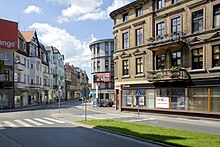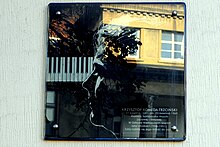Ostrów Wielkopolski
Ostrów Wielkopolski | ||
|---|---|---|
 Aerial view of downtown Ostrów Wielkopolski | ||
|
Car plates POS | | |
| Climate | Cfb | |
| Highways | ||
| National roads | ||
| Voivodeship roads | ||
| Website | http://www.umostrow.pl/ | |
Ostrów Wielkopolski (.
History

Recently[when?], a small fortified dwelling dating from the 10th century was discovered on the north-east side of the town's limits. An archeological excavation is now[when?] in progress. It was part of Poland since the establishment of the state in the 10th century.
The oldest known mention of Ostrów comes from a document from 1293. Ostrów received
During the

Ostrów was an important center of Polish resistance and national liberation movements.
World War II

During the German invasion of Poland, which started World War II, the Einsatzgruppe III entered the city on September 7–9, 1939 to commit various crimes against Poles, and also the SS-Totenkopf-Standarte Brandenburg operated in the city.[5] During the German occupation of Poland, local Poles were subjected to mass arrests, imprisonment, deportations to concentration camps, expulsions, forced labour and massacres.
In late 1939 and early 1940, many Poles were arrested during the
The Germans carried out first expulsions of Poles in October 1939, focusing on owners of bakeries, cafes, workshops and large apartments, which were then handed over to German colonists as part of the Lebensraum policy, while expelled Poles were held in a transit camp in nearby Nowe Skalmierzyce for several weeks, and then deported to the General Government (German-occupied central Poland).[13] Further 160 Poles were expelled in December 1939 to the Radom District of the General Government.[14] Also a transit camp for Poles expelled from nearby villages was established in the local church.[14] Further expulsions of Poles were carried out in 1940–1941.[15]
The town was one of the major
Recent period

After the war Ostrów Wielkopolski was part of the Poznań Voivodeship, and from 1975 to 1998 it was the second largest city of the Kalisz Voivodeship (behind Kalisz).
In September 1945, the Polish resistance movement made an unsuccessful attempt to capture the local communist jail and liberate the prisoners.[19] In July–August 1980, employees of local factories joined the nationwide anti-communist strikes,[20] which led to the foundation of the "Solidarity" organization.
In 1979 Ostrów's city limits were widely expanded for the second time, including the former villages Pruślin, Szczygliczka, Zacharzew, Piaski, Stary Staw and Nowy Staw as new districts.
Sights
Ostrów has a well-preserved city center, with such sights as:
- City hall (Ratusz) at the Market Square (Rynek), housing the local museum
- Ostrów Wielkopolski Co-Cathedral
- Virgin Mary Queen of Poland church
- I Liceum Ogólnokształcące, the city's oldest high school, and one of the most renowned high schools of Greater Poland
- Main Post Office
- Monument of Primate of Poland Mieczysław Halka-Ledóchowski
- Former synagogue
Places of interest outside the city center include:
- Old Cemetery (Stary Cmentarz), the oldest active Catholic cemetery in Poland
- New Cemetery (Nowy Cmentarz), opened in 1905, resting place of many distinguished figures of Ostrów, and Greater Poland insurgents, including the first fallen insurgent Jan Mertka]
- Park 3 Maja (3 May Park)
- Park Miejski (Municipal Park)
- Ogród Bracki (Bracki Garden)
-
City hall at the Market Square
-
Ostrów Wielkopolski Co-Cathedral
-
Virgin Mary Queen of Poland church
-
I Liceum Ogólnokształcące
-
Main Post Office
-
Facades of old townhouses in the city center
-
Old Cemetery
-
Graves of participants of theGreater Poland Uprising
-
Monument of Mieczysław Halka-Ledóchowski
-
Elementary School No. 2
-
Former synagogue
-
Park Miejski
Education
- Społeczna Wyższa Szkoła Przedsiębiorczości i Zarządzania in Łódź, branch in Ostrów Wlkp.
- Technical University of Łódź, branch in Ostrów Wlkp.
Sports
- Polska Liga Koszykówki (top division), 2020–21 season champions, 2019 Polish Basketball Cupwinners
- Ostrovia 1909 Ostrów Wielkopolski – men's soccer team, who play at the Ostrów Wielkopolski Municipal Stadium
- TZ Ostrovia Ostrów Wielkopolski – speedway team, who race at the Ostrów Wielkopolski Municipal Stadium
- Arged KPR Ostrovia Ostrów Wielkopolski – men's handball team, playing in the PGNiG Superliga (top division).
From 5 July to 20 July 2013 Ostrów Wielkopolski hosted the 17th European Gliding Championships. Local pilot Łukasz Błaszczyk took a bronze medal in the Club Class.[21]
Notable people

- Bartłomiej Jaszka (born 1983), Polish handball player
- Krzysztof Komeda (1931–1969), Polish film score composer and jazz pianist
- Krzysztof Kwiatkowski (born 1971), computer scientist, researcher, software developer; former Minister of Justice
- Moritz Landé (1829–1888), German architect
- Krzysztof Lijewski (born 1983), Polish handball player
- Marcin Lijewski (born 1977), Polish handball player
- Władysław Marcinkowski (1858–1947), Polish sculptor
- Władysław Markiewicz (1920–2017), Polish sociologist
- Mateusz Ponitka (born 1993), Polish basketball player
- Bernhard Rawitz (1857–1932), German anatomist
- Red Baron", German fighter pilot (World War I); briefly stationed in the city's cavalry unit before being sent to the Western Front
- Jan Żniniewicz (1872–1952), Polish physician, author of the new method of hydrotherapy (balneological method of treatment of chronic rheumatic diseases)
International relations
Twin towns — sister cities
Ostrów Wielkopolski is
|
|
References
- ^ a b "Local Data Bank". Statistics Poland. Retrieved 15 August 2022. Data for territorial unit 3017011.
- ^ a b c d e f g h i j Witold Banach. "Historia kołem się toczy". UMOstrów.pl (in Polish). Retrieved 8 February 2020.
- ^ Bernadeta Kruszyk. "Mieczysław Ledóchowski". Archidiecezja Gnieźnieńska (in Polish). Retrieved 8 February 2020.
- ^ Smoleń, Bogusław (1930). Zarys historji wojennej 60-go Pułku Piechoty Wielkopolskiej (in Polish). Warszawa. p. 25.
{{cite book}}: CS1 maint: location missing publisher (link) - ^ Wardzyńska, Maria (2009). Był rok 1939. Operacja niemieckiej policji bezpieczeństwa w Polsce. Intelligenzaktion (in Polish). Warszawa: IPN. pp. 56–57, 61–62.
- ^ Wardzyńska (2009), p. 205-206
- ^ Wardzyńska (2009), p. 206
- ^ Wardzyńska (2009), p. 117
- ^ "NS-Gefängnis Ostrowo". Bundesarchiv.de (in German). Retrieved 11 December 2020.
- ^ Wardzyńska (2009), p. 212-213
- ^ Wardzyńska (2009), p. 213-214
- ^ "Offer to sell domain: Kalisz.eu".
- ISBN 978-83-8098-174-4.
- ^ a b Wardzyńska (2017), p. 181
- ^ Wardzyńska (2017), p. 268, 319
- ISSN 1641-9561.
- ISBN 83-85003-97-5.
- ^ Marek Weiss, Przed 73 laty w Ostrowie okupacja dobiegła końca, „Ziemia Kaliska”, No. 4, 2018, p. 10 (in Polish)
- ISSN 1641-9561.
- ISSN 1641-9561.
- ^ Website of 17th European Gliding Championships
- ^ "Brantford Expositor – City gets a twin". Archived from the original on 2012-07-23. Retrieved 2009-05-31.













